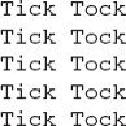Java Reference
In-Depth Information
Here is the output produced by the program:
Let's take a close look at this program. The heart of the clock is the
TickTock
class. It
contains two methods,
tick( )
and
tock( )
, which communicate with each other to ensure
that a Tick is always followed by a Tock, which is always followed by a Tick, and so on.
Notice the
state
field. When the clock is running,
state
will hold either the string "ticked"
or "tocked", which indicates the current state of the clock. In
main( )
, a
TickTock
object
called
tt
is created, and this object is used to start two threads of execution.
The threads are based on objects of type
MyThread
. The
MyThread
constructor is
passed two arguments. The first becomes the name of the thread. This will be either "Tick"
or "Tock". The second is a reference to the
TickTock
object, which is
tt
in this case. Inside
the
run( )
method of
MyThread
, if the name of the thread is "Tick", then calls to
tick( )
are made. If the name of the thread is "Tock", then the
tock( )
method is called. Five calls
that pass
true
as an argument are made to each method. The clock runs as long as
true
is
passed. A final call that passes
false
to each method stops the clock.
The most important part of the program is found in the
tick( )
and
tock( )
methods of
TickTock
. We will begin with the
tick( )
method, which, for convenience, is shown here:


